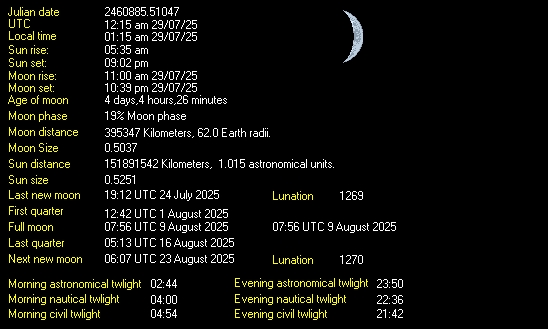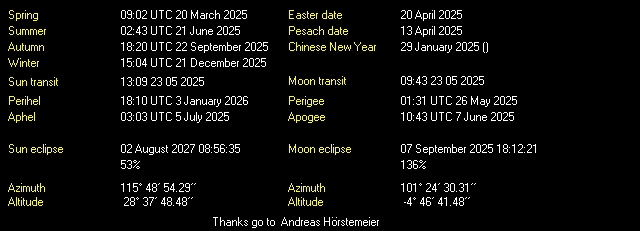Uncategorised


Northern Lights

Images taken from this location using our Meade ETX90 Maksutov Cassegrain Telescope.
Lunar Pictures

Image taken on the evening of 10th Jan 2009. The moon was at it's closest to the earth for 2009, being 357,500 kilometers from Earth. The Moon does not orbit Earth in a perfect circle. Instead, it follows an elliptical path that brings it 50,000 kilometres closer to our planet on one side of its orbit (called perigee) than the other (apogee).
Solar Imaging
DO NOT LOOK DIRECTLY INTO THE SUN WITH A TELESCOPE WITHOUT THE CORRECT FILTERS

Image taken in the morning, showing the Transit of Venus. The previous transit was in 1882, so no living person had observed this until 2004. The next visible transit will be 5-6th June 2012. If the transit is visible, we hope to get more pictures, including the teardrop phase.
Alas, it was cloudy and rain on the 6th June, 2012. No observation was possible.
Next Transit will be 8th December, 2125 so only another 103 years to wait ...
In our time in Ottery St Mary, the weather station appeared on the BBC, and the Local papers after the Storm in October 2008.
Ottery Herald - 28th November 2008
Media : Print / On-line
Back garden weather man from Ottery St Mary
AMATEUR weather recorder Damian Coombes could be Ottery's best kept secret.
An IT worker by day, Damian has spent the last two years developing a hobby in which he records and predicts Ottery's weather peculiarities. From temperature and rainfall to lightening strikes and even earthquakes, and he does it all from his back- garden.
Damian, 31, built his one-man weather station from a scrapped Davis Weather Monitor II, given to him in 2006 and has been publishing the town's meteorological details, which include soil temperature, leaf wetness and solar radiation, ever since.

Townsfolk can also check out a live weather display and 24-hour weather updates specific to the town from the station which uses instruments on an antenna mast in Damien's garden. Data then goes to a computer which utilises an array of software to process the information.
Self-taught weather enthusiast Damain said: "I've always been interested in weather and the science behind it- measurements and instruments- and I have just combined that with what I do for a living.
"This is just a non-profit hobby, in fact it costs me, it just so happens everybody can come and have a look at it, its a repository of weather data.
"While it (the data) is there for everyone to look at, as with all forecasts accuracy is not 100 per cent accurate, and I can't make any guarantees on it. What is available to amateurs is totally different than what the professionals have, they have time and development we don't."
Damian said his website has averaged 2000 hits a day since it started, but he, like the Met Office was left flummoxed by the freak storm which battered Ottery last month.
He added: "I have to admit I didn't see it coming, but its one of those events that happens every 125 years. Ironically my lightening sensor had only just been put up but got wiped out by the strikes that night. I'm glad I was awake, its not something you are to see for a long time. There was about 77mm of rain in a few hours, the highest id ever seen was 35mm."
You can check Ottery's weather at www.lucidia.co.uk/weather/
Davisnet.com - 17th Jan 2009 (Davis Weather Station - News Page Jan 2009)
Media : On-line
Damian’s a Weather Ace!
We don't know if Damian Coombes was more excited that he made the Sidmouth Herald, or that he was referred to as "Weather Ace Damian" in the headline!
The Ottery, Devon, UK, man has made a name for himself with his one-man weather station which he built by adapting a scrapped Davis Weather Monitor II. He has been publishing all sorts of data, including leaf wetness and solar radiation, since 2006.
But what we like best about Damian's story was found on his website, where he explains that his original Weather Monitor II was first deployed in 1992! (Babies born in 1992 are now graduating high school!)
Damian writes, "I think this shows you get what you pay for with weather recording equipment! I shall be buying a Davis when this one finally fails in a way that I cannot fix."
At this rate, we may never get to send a new Vantage Pro2 to Damian.
http://davisnet.com/news/e_news_archive/2009-01.asp
BBC TV - 4th Feb 2009 - 19:30
Media : Television
Inside Out - BBC Southwest
David Braine looks at the world of the Amatuer Weather Forecaster.
The Ottery St Mary Weather station took part in the first ever Weather Forecast Challenge against the UK Meteorological Office and their super computers. This Programme looked at the Weather Observers around the Southwest who record and in our case try our hand at forecasting the weather.
http://www.bbc.co.uk/insideout/content/articles/2009/02/02/south_west_weather_s15_w4_feature.shtml


Screenshots and Web Content - Produced by BBC Southwest 2009
RMetS Weather Journal - October 2009
Media : Print / On-line
Exceptional hailstorm hits Ottery St Mary on 30 October 2008 (p 255-263)

Nick Grahame, Bob Riddaway, Alison Eadie, Baden Hall, Ewen McCallum
Our data has been used by the Met Office as part of an investigation into the Ottery Storm of 2008. Thanks to the team for working with us over the last 12 months. The article is a very in-depth investigation into the event and the atmospheric conditions at the time, and an excellent read. Congratulations to all the authors.
For more information visit the Royal Meteorological Society website.

The Fitzroy Stormglass was invented by Admiral Robert Fitzroy. The glass vessel contains a mixture of distilled water, ethanol, potassium nitrate, ammonium chloride, and camphor.

It is not explained how or why the stormglass actually works, as the physical changes cannot be explained from the conditions proceeding the weather event that is forecast. The basic explanation is that the pressure and temperature cause the liquid to change it's solubility, thus causing patterns of crystals to form within the tube.
I purchased my Stormglass from Weather in a Bottle many years ago, however is looks like the company closed in 2020 and therefore here is a link to their site that was archived by the Wayback machine from 2020. This is a real shame, as although there are a lot of far-eastern, Amazon purchasable StormGlass, they are not as accurate or nicely made as this one.
Images
The formation of these ferns should forecast windy conditions, in approx 2 days. This was quite accurate as we did experience windy conditions around 2 days later.

